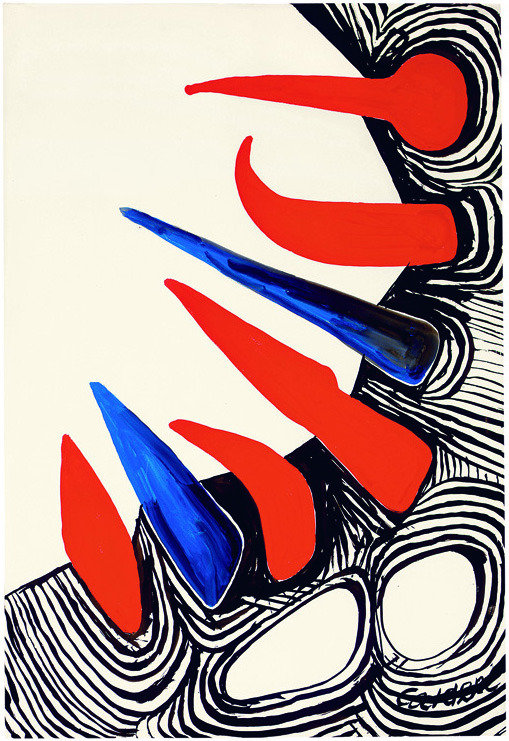Alexander Calder
dal 9/6/2014 al 25/7/2014
Segnalato da
9/6/2014
Alexander Calder
Gagosian Gallery 2, London
Gouaches. Adapting certain aspects of his sculptures relating to their angularity and kineticism, the gouaches present a synthesis of these geometric forms with more earthly, representational subjects.

What I produce is not precisely what I have in mind--but a sort of sketch, a man-made approximation. That others grasp what I have in mind seems unessential ... as long as they have something else in theirs.
--Alexander Calder
Gagosian London is pleased to present "Alexander Calder: Gouaches," the second installment of a two-venue exhibition in New York and London.
In the late 1920s, Calder's new method of sculpting--bending and twisting wire to "draw" three-dimensional figures in space--resonated with both early Conceptual and Constructivist art, as well as the language of early abstract painting. Seeking to capture the constant motion of life, he created kinetic sculptures in which flat, abstract shapes in light sheet metal, painted in a restricted palette of black, white, or bright primary colors, hang in perfect balance from wires. Marcel Duchamp was the first to describe the new works as "mobiles," while standing "stabiles" employed welding and bolting techniques to reject the weight and solidity of sculptural mass, to produce forms that were both linear and planar, open and suggestive of motion. By 1950, Calder had achieved international renown, affording him opportunities to engineer his sculpture on a monumental scale.
Parallel to his sculptural practice, and expanding upon early work in illustration, brush drawing, and painting, Calder created a series of paintings in gouache during a yearlong stay in Aix-en-Provence in 1953. He would continue to work in gouache throughout his life. Painting quickly, he transcribed the vocabulary of his sculpture into a medium far more immediate than the large-scale works in sheet metal produced simultaneously. Adapting certain aspects of his sculptures relating to their angularity and kineticism, the gouaches present a synthesis of these geometric forms with more earthly, representational subjects. The spiraling vortices of his early wire sculptures reappear atop pyramids (a recurring motif following a flight over Egypt), or hovering beside red suns (impressions of Guatemala's fiery sunrises). Boulders, solar systems, and cacti are points of departure for his exuberant line, which conveys arabesques, orbs, and layers of bold stripes. Delighting in nature and evoking the subconscious, Calder celebrated essential yet enigmatic forms in an array of ochres, yellows, and vermilion, a vivid palette reserved for a lifetime of spontaneous impressions.
Alexander Calder was born in Pennsylvania in 1898 and attended the Stevens Institute of Technology and Art Students League. He died in New York City in 1976. His work is included in public and private collections worldwide, including Whitney Museum of American Art, New York; Museum of Modern Art, New York; Centre Georges Pompidou, Paris; and National Gallery of Art, Washington, D.C. Calder's public commissions are on view in cities throughout the world, and his work has been the subject of hundreds of museum exhibitions, including "Alexander Calder: 1898-1976," National Gallery of Art, Washington, D.C. (1998, traveled to San Francisco Museum of Modern Art); "Calder: Gravity and Grace," Guggenheim Bilbao, Spain (2003, traveled to Museo Nacional Centro de Arte Reina Sofía, Madrid); "The Surreal Calder," Menil Collection, Houston (2005, traveled to San Francisco Museum of Modern Art and Minneapolis Institute of Arts, through 2006); "Calder Jewelry," Norton Museum of Art, West Palm Beach (2008, traveled to Philadelphia Museum of Art; Metropolitan Museum of Art, New York; Irish Museum of Modern Art, Dublin; San Diego Museum of Art; and Grand Rapids Art Museum); "Alexander Calder: The Paris Years, 1926-1933," Whitney Museum of American Art, New York (2008, traveled to Centre Georges Pompidou, Paris; and Art Gallery of Ontario, Toronto); "Calder: Sculptor of Air," Palazzo delle Esposizioni, Rome (2009-10); "Alexander Calder: A Balancing Act," Seattle Art Museum (2009-10); "Alexander Calder and Contemporary Art," Museum of Contemporary Art, Chicago (2010, traveled to Orange County Museum of Art, Newport Beach, CA; Nasher Sculpture Center, Dallas; and Nasher Museum of Art at Duke University, Durham, NC); "Calder's Portraits: A New Language," National Portrait Gallery, Washington, D.C. (2011); and "Calder," Leeum, Samsung Museum of Art, Seoul (2013). "Calder Gallery II" is on view at Fondation Beyeler, Riehen, Switzerland through June 2014.
For further information please contact the gallery at london@gagosian.com or at +44.207.493.3020. All images are subject to copyright. Gallery approval must be granted prior to reproduction.
Image: © 2014 Calder Foundation, New York/Artists Rights Society (ARS), New York
London Press Enquiries
Bolton & Quinn
T. +44.207.221.5000
www.boltonlquinn.com
Contact: Erica Bolton
E. erica.bolton@boltonquinn.com
OPENING RECEPTION: Tuesday, June 10, 6-8pm
Gagosian Gallery
17-19 Davies Street, London W1K 3DE
Hours: Tue–Sat 10-6



